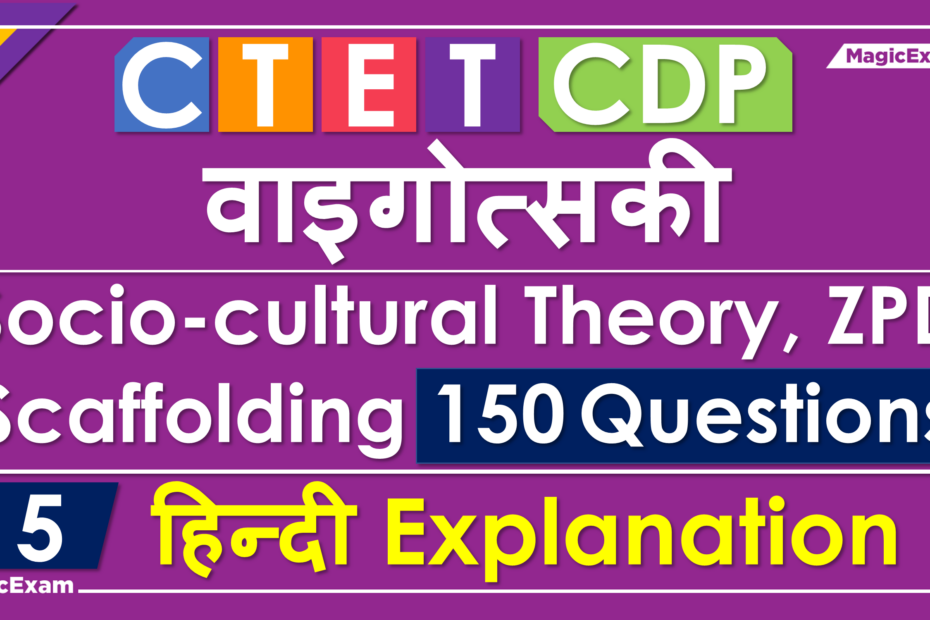Subscribe to MagicExam YouTube channel for free videos on CTET 2025 and 2026, KVS, TET, REET, DSSSB, UPTET, MPTET, MahaTET, APTET, TSTET, RTET, HTET, PSTET, KARTET, TNTET and other Teaching exam preparation, solved question papers, syllabus analysis, result related news and other information videos.
If you have any questions, comments or feedback - please post them as YouTube comments under the specific videos and we will clarify or reply as soon as possible.
Answer for the Question : 00:00 – Introduction
Answer for the Question : 01:02 – How are children understood in a constructivist frame ? -Passive beings -Miniature adults -As being born evil who have to be civilized -As being born with a curiosity to explore the world
Answer for the Question : 01:47 – How should a teacher respond to young children talking out loud to themselves (self-talk) ? -Discourage it because it promotes ego-centricism -Discourage it because it is distracting for the child herself -Encourage it because it facilitates self-regulation -Encourage it because this ends teacher’s responsibility
Answer for the Question : 02:55 – In a child-centred classroom children -are looked at as passive imitators -are actively engaged in construction of knowledge -are eager to copy answer from blackboard as it is -have to be passive listeners only
Answer for the Question : 04:27 – In a child-centred classroom learning -happens by pairing of stimulus-response associations -is dependent on rewards and punishment -is co-constructed by the teacher and students -is dependent solely on the teacher and student’s role is passive
Answer for the Question : 05:38 – In a child-centred classroom students -do not have much role in their own learning -are active constructors of knowledge -are looked upon as blank slates -passively imitate the teachers and follow her
Answer for the Question : 06:49 – In a child-centered classroom, teachers -do not have any role -take a passive role -create a collaborative classroom ethos to promote learning -have the role of a dictator to instruct children
Answer for the Question : 08:20 – In a class comprising of culturally diverse students, which of the following should be avoided by a teacher ? -Bringing examples from diverse cultures in the discussion -Developing curriculum and teaching style suitable to dominant culture -Encouraging students to share unique features of their culture -Promoting a culture of respect and acceptance among students
Answer for the Question : 10:35 – In a classroom, students are working in small groups on a task and teacher facilitates each group. Which approach is being followed in the classroom ? -Behaviouristic -Constructivistic -Psychoanalytic -Expository
Answer for the Question : 11:50 – In a constructivist classroom as envisioned by Piaget and Vygotsky the teacher -Gives long lectures on various topics -Provides an opportunity to the students to engage in inquiry and problem-solving -Takes a backseat and observe the students -Dictates answers to all the questions in the textbook
Answer for the Question : 14:16 – In a constructivist classroom as envisioned by Piaget and Vygotsky, learning ? -Is offering the reinforcement by the teacher -Is constructed by the students themselves who play an active role -Is dictated by the student are passive recipients of the same -Happens by pairing of a stimulus and a response
Answer for the Question : 16:04 – In a constructivist frame, learning is- -a change in behaviour as a result of experience -active and social in its character -passive and individualistic -the process of acquisition of knowledge
Answer for the Question : 18:17 – In a multi-lingual classroom, a teacher should -Discourage the use of native language for communication -Recognize only the predominant language that is used by majority students -Create awareness about diversity of languages and allow their use as per student’s preference -Discourage the use of languages other than one target language such as English
Answer for the Question : 20:49 – In a progressive classroom -teaching is textbook-centric -emphasis is placed on summative assessment -learners play an active part in their learning -teachers use rewards and punishment to direct children’s learning
Answer for the Question : 22:44 – In a progressive classroom, learning -is a simple process -is a social process -can take place only through formal instruction -is conditional upon exams
Answer for the Question : 25:15 – In a progressive classroom, learning -takes place through interaction and dialogue -is a one-way transmission from the teacher to the learners -takes place through passive reception -is the responsibility of the learners only and teachers do not have any role
Answer for the Question : 27:53 – Conclusion
Click on the YouTube video link in the article above, to watch the entire video on YouTube. You can also click on the 'Chapter' link time-stamps to go directly to the specific question or part of the video.
Subscribe to MagicExam YouTube channel for free videos on CTET 2025 and 2026, KVS, TET, REET, DSSSB, UPTET, MPTET, MahaTET, APTET, TSTET, RTET, HTET, PSTET, KARTET, TNTET and other teaching exam preparation, solved question papers, syllabus analysis, result related news and other information videos.
If you have any questions, comments or feedback - please post them as YouTube comments under the specific videos and we will clarify or reply as soon as possible.
